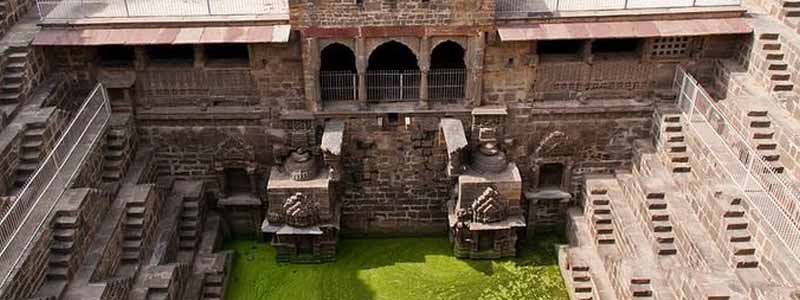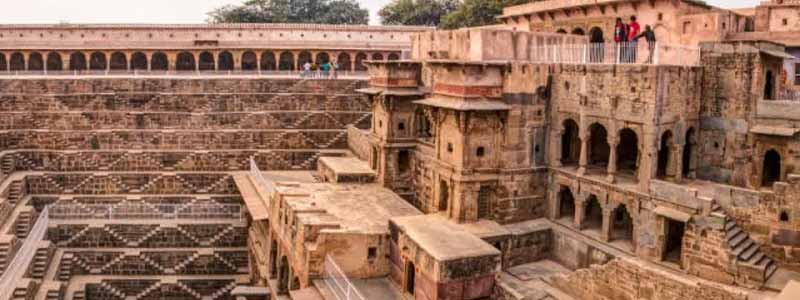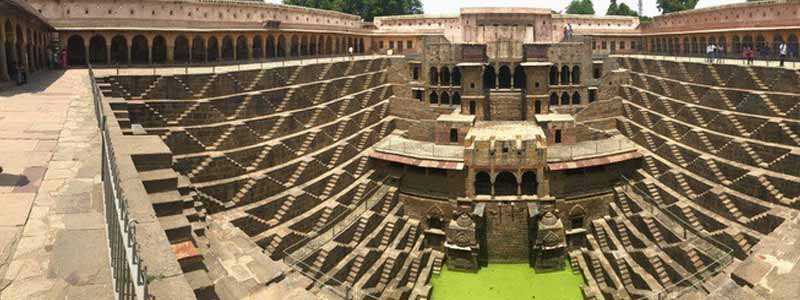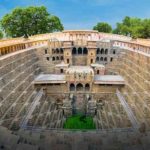Abhaneri Travel Guide – Chand Baori (stepwell) in the Abhaneri village is one of the oldest and most popular attractions in Rajasthan. It was built by King Chanda of the Nikumbha Dynasty in 9th century AD. One of the largest stepwells in the world, Chand Baori was built to conserve water and provide a respite from the intense heat. It was a community gathering place for locals as well as royals. Chand Baori is an architectural wonder with 3,500 perfectly symmetrical, narrow steps. It is this exquisite geometry that draws local and international visitors to it every year. But Chand Baori is not easy to find, making it one of India’s hidden wonders.
Abhaneri Travel Guide The play of light and shadow on the steps is what makes the structure so captivating. The baori narrows as one gets closer to the bottom. A double flight of steps on three sides takes one to the surface of the water below. The fourth side is a three-storeyed pavilion with intricately carved jharokhas (windows), galleries and balconies meant for the royal family to sit in. Adjoining the Chand Baori is the Harshat Mata Temple. This 9th-10th century temple is dedicated to Harshat Mata, who is considered to be the goddess of joy and happiness for the whole village.

History of Abhaneri Step Well –
Abhaneri Travel Guide With its history dating back to the 8th Century, Abhaneri Step Well was built by Raja Chanda. Raja Chanda belonged to the Nikhumba Dynasty which ruled the region for almost 400 years.
Raja Chanda had his faith in Harshat Mata, the goddess of joy and happiness. To please Harshat Mata and help the people in his kingdom, Raja Chanda built this step well. Also, there was a temple attached to the stepwell dedicated to Harshat Mata.
It was partially razed in the 10th century but with time, the temple was repaired. Due to its geographical setting and climatic resolutions, the region often faced water scarcity. Abhaneri Travel Guide To cope up with this problem, Raja Chanda started the construction of the stepwell. In its original setting,
Abhaneri Step Well was only a step well with steps leading to the bottom. In the 18th century when the Mughals invaded the region, they rebuilt the stepwell and constructed walls and built some galleries around the well.
Abhaneri Step Well houses the annual Abhaneri festival which occurs before the Sharad Navratri. The festival is celebrated to embrace and thank Goddess Harshat Mata in a period of 3-days.
During the festival, a diving competition is conducted where the young men of the village participate. Also, the step well is very popular globally that it attracts more international visitors than national.
The Harshat Temple near the stepwell is older than the stepwell and was built around the 7th century. The name of the village, Abhaneri is said to be originated from the blessings of Harshat Mata who endowed to spread brightness (abha) in the lives of the people.

Travel Tips
- Abhaneri is in Dausa district of Rajasthan, about 90 km from Jaipur. It is best to do it as a day trip from Jaipur.
- On the way to Chand Baori, you can also visit Bhangarh Fort – the most haunted place in India.
- You need 30-60 minutes to see Abhaneri. I spent about 2 hours as I was exploring all possible sculptures.
- Guides are available at the site, but if you have read this post, you would not really need them.
Architecture of Chand Baori Abhaneri
The architectural masterpiece that it is, Chand Baori is a four- sided structure with the famed 19.5 metres deep geometric steps of the step well covering the Baori from three sides and the fourth side is covered by the prominent corridor building with multi-storeyed pavilions.
The top of the pavilions have several jharokhas (windows) to get the view of the well from here. The bottom most part of the pavilions has recesses that hold stone sculptures in them along with religious carvings.
The pavilion houses a grand room with a separate stage that is believed to have been meant for the royals to enjoy performances by artists of the court. There is also a room that appears to be the royal residence. There are galleries that take visitors towards the balconies projecting out, that are supported by pillars and house beautiful sculptures of Goddess Mahishasurmardini and Lord Ganesha.
The structure of the palace building was renovated or retouched by the Chauhanas and the Mughals. This is proved by the presence of trabeated arches that were typical architectural style used by the Chauhan rulers and the cusped arches, famous in all structures built by the Mughals. The entry to this part of the corridor is now restricted for tourists.
The major attraction of the baori is the incredibly designed double flight geometric steps descending into the water body. There are 3,500 steps built in 13 levels that finally lead to the well and tapers down as one reaches to the bottom, nearer to the water.
It should be noted that the entire structure is built out of porous volcanic rocks and stones. This enables the water to seep through the stones and reach to the bottom of the water pool or the well. As one climbs down towards the end of the steps, the temperature surrounding the area drops by almost 5- 6 degrees as compared to the temperature on top of the Abhaneri Travel Guide.
The triangular pattern of the steps makes one climb down sideways and this adds to the aesthetics of the architecture. The other possible reason to build the steps in such fashion is to allow access to more people at one time. Abhaneri Travel Guide A closer look at the bottom of the steps would reveal the presence of concealed shafts that were supposedly used to pull water out from the pool.

Best time to visit Chand Baori
October to March is the best time to visit the place. Preferably September or October is the ideal time to visit because of the Abhaneri Village Festival. Even the place is a small rustic village it provides as the perfect long weekend goal.
How to Reach Chand Baori
Air: Delhi and Jaipur provide convenient access to Abhaneri Travel Guide. They are the nearest airports. From there you can take a bus or cab to Abhaneri.
Rail: Jaipur offers the most expedient railway access to Abhaneri. It is the nearest railhead.
Road: Abhaneri lies off NH-11 connecting Agra to Jaipur. You can drive to Abhaberi from these places or you could come by bus too. Buses are available to get to Abhaneri Travel Guide.
The Chand Baori can be found in Abhaneri, about 95 km from Jaipur. A convenient detour off the much-feted Golden Triangle route-Delhi, Jaipur and Agra, Chand Baori is a less sought after destination that is worth the effort to visit it.
Abhaneri Travel Guide can be best reached from Jaipur. There are no direct bus lines, thus you have two options to reach Abhaneri by public transportation.








